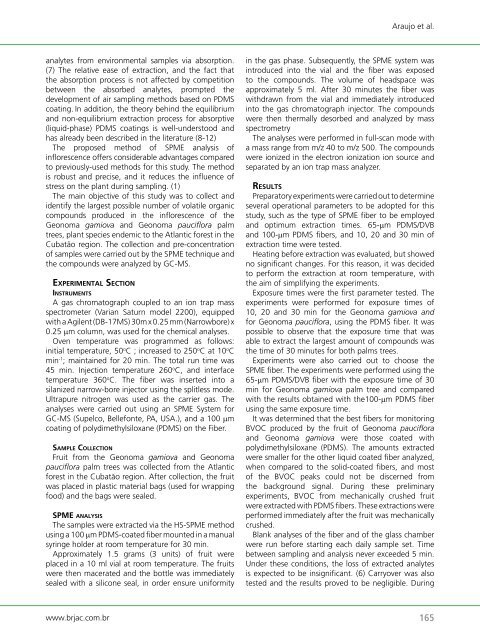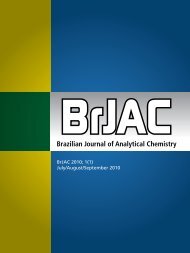Brazilian Journal of Analytical Chemistry - BRJAC - Brazilian Journal ...
Brazilian Journal of Analytical Chemistry - BRJAC - Brazilian Journal ...
Brazilian Journal of Analytical Chemistry - BRJAC - Brazilian Journal ...
Create successful ePaper yourself
Turn your PDF publications into a flip-book with our unique Google optimized e-Paper software.
analytes from environmental samples via absorption.<br />
(7) The relative ease <strong>of</strong> extraction, and the fact that<br />
the absorption process is not affected by competition<br />
between the absorbed analytes, prompted the<br />
development <strong>of</strong> air sampling methods based on PDMS<br />
coating. In addition, the theory behind the equilibrium<br />
and non-equilibrium extraction process for absorptive<br />
(liquid-phase) PDMS coatings is well-understood and<br />
has already been described in the literature (8-12)<br />
The proposed method <strong>of</strong> SPME analysis <strong>of</strong><br />
inflorescence <strong>of</strong>fers considerable advantages compared<br />
to previously-used methods for this study. The method<br />
is robust and precise, and it reduces the influence <strong>of</strong><br />
stress on the plant during sampling. (1)<br />
The main objective <strong>of</strong> this study was to collect and<br />
identify the largest possible number <strong>of</strong> volatile organic<br />
compounds produced in the inflorescence <strong>of</strong> the<br />
Geonoma gamiova and Geonoma pauciflora palm<br />
trees, plant species endemic to the Atlantic forest in the<br />
Cubatão region. The collection and pre-concentration<br />
<strong>of</strong> samples were carried out by the SPME technique and<br />
the compounds were analyzed by GC-MS.<br />
experImental sectIon<br />
Instruments<br />
A gas chromatograph coupled to an ion trap mass<br />
spectrometer (Varian Saturn model 2200), equipped<br />
with a Agilent (DB-17MS) 30m x 0.25 mm (Narrowbore) x<br />
0.25 µm column, was used for the chemical analyses.<br />
Oven temperature was programmed as follows:<br />
initial temperature, 50 o C ; increased to 250 o C at 10 o C<br />
min -1 ; maintained for 20 min. The total run time was<br />
45 min. Injection temperature 260 o C, and interface<br />
temperature 360 o C. The fiber was inserted into a<br />
silanized narrow-bore injector using the splitless mode.<br />
Ultrapure nitrogen was used as the carrier gas. The<br />
analyses were carried out using an SPME System for<br />
GC-MS (Supelco, Bellefonte, PA, USA.), and a 100 µm<br />
coating <strong>of</strong> polydimethylsiloxane (PDMS) on the Fiber.<br />
sa m p l e co l l e c t Io n<br />
Fruit from the Geonoma gamiova and Geonoma<br />
pauciflora palm trees was collected from the Atlantic<br />
forest in the Cubatão region. After collection, the fruit<br />
was placed in plastic material bags (used for wrapping<br />
food) and the bags were sealed.<br />
spme a n a l y s Is<br />
The samples were extracted via the HS-SPME method<br />
using a 100 µm PDMS-coated fiber mounted in a manual<br />
syringe holder at room temperature for 30 min.<br />
Approximately 1.5 grams (3 units) <strong>of</strong> fruit were<br />
placed in a 10 ml vial at room temperature. The fruits<br />
were then macerated and the bottle was immediately<br />
sealed with a silicone seal, in order ensure uniformity<br />
www.brjac.com.br<br />
Araujo et al.<br />
in the gas phase. Subsequently, the SPME system was<br />
introduced into the vial and the fiber was exposed<br />
to the compounds. The volume <strong>of</strong> headspace was<br />
approximately 5 ml. After 30 minutes the fiber was<br />
withdrawn from the vial and immediately introduced<br />
into the gas chromatograph injector. The compounds<br />
were then thermally desorbed and analyzed by mass<br />
spectrometry<br />
The analyses were performed in full-scan mode with<br />
a mass range from m/z 40 to m/z 500. The compounds<br />
were ionized in the electron ionization ion source and<br />
separated by an ion trap mass analyzer.<br />
results<br />
Preparatory experiments were carried out to determine<br />
several operational parameters to be adopted for this<br />
study, such as the type <strong>of</strong> SPME fiber to be employed<br />
and optimum extraction times. 65-µm PDMS/DVB<br />
and 100-µm PDMS fibers, and 10, 20 and 30 min <strong>of</strong><br />
extraction time were tested.<br />
Heating before extraction was evaluated, but showed<br />
no significant changes. For this reason, it was decided<br />
to perform the extraction at room temperature, with<br />
the aim <strong>of</strong> simplifying the experiments.<br />
Exposure times were the first parameter tested. The<br />
experiments were performed for exposure times <strong>of</strong><br />
10, 20 and 30 min for the Geonoma gamiova and<br />
for Geonoma pauciflora, using the PDMS fiber. It was<br />
possible to observe that the exposure time that was<br />
able to extract the largest amount <strong>of</strong> compounds was<br />
the time <strong>of</strong> 30 minutes for both palms trees.<br />
Experiments were also carried out to choose the<br />
SPME fiber. The experiments were performed using the<br />
65-µm PDMS/DVB fiber with the exposure time <strong>of</strong> 30<br />
min for Geonoma gamiova palm tree and compared<br />
with the results obtained with the100-µm PDMS fiber<br />
using the same exposure time.<br />
It was determined that the best fibers for monitoring<br />
BVOC produced by the fruit <strong>of</strong> Geonoma pauciflora<br />
and Geonoma gamiova were those coated with<br />
polydimethylsiloxane (PDMS). The amounts extracted<br />
were smaller for the other liquid coated fiber analyzed,<br />
when compared to the solid-coated fibers, and most<br />
<strong>of</strong> the BVOC peaks could not be discerned from<br />
the background signal. During these preliminary<br />
experiments, BVOC from mechanically crushed fruit<br />
were extracted with PDMS fibers. These extractions were<br />
performed immediately after the fruit was mechanically<br />
crushed.<br />
Blank analyses <strong>of</strong> the fiber and <strong>of</strong> the glass chamber<br />
were run before starting each daily sample set. Time<br />
between sampling and analysis never exceeded 5 min.<br />
Under these conditions, the loss <strong>of</strong> extracted analytes<br />
is expected to be insignificant. (6) Carryover was also<br />
tested and the results proved to be negligible. During<br />
165



